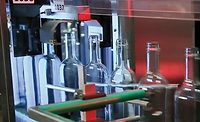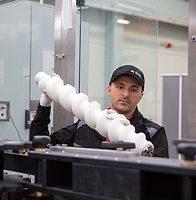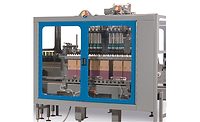A product’s packaging can play just as much of a roll in a products success as what is inside. To ensure the product and package quality remains intact, packaging inspection suppliers are staying on top of the latest category and packaging trends within the beverage industry.
“The equipment is designed toward the type of container,” says Robert Chevalier, engineering manager at Teledyne TapTone North Falmouth, Mass. “The trends of inspection equipment follow the trends of the packages themselves.”
Therefore, trends such as lightweighting, carton packaging and moving toward new formats all have spurred a need for innovation from packaging inspection suppliers.
“As packaging materials continue to get lighter, and container and closure shapes get more challenging, the technology to inspect the containers has been adapting,” FT System North America’s General Manager Rick Reardon says.
Convenience conundrum
Convenience is a key driver in beverage packaging at the moment. Consumers are often looking for multipacks, which brings about more cartoning but allows the consumer to quickly grab a several varieties at once. Also, a move toward primary packaging options that are more portable and less breakable, like pouches and cans, has been a prevalent shift recently.
According to reporting by Food and Beverage Packaging, pouches are one of the most rapidly growing beverage formats. And Teledyne’s Chevalier agrees: “A lot of manufacturers are going to pouches, all non-carbonated beverages.”
This move toward pouches has opened an opportunity for innovation, which Teledyne jumped on. “There’s not a lot of inspection equipment for the pouch,” Chevalier says. “We’ve developed new inspection equipment to specifically inspect pouches. Right now, it’s called the Pro-series Dual Sensor Compressions (DSC).”
The Pro-series DSC squeezes pouches and measures the loss of pressure to find leaks, according to Chevalier.
Pouches aren’t the only format that is growing, cans offer another form of convenience that consumers are looking for, which has offered another opportunity for innovation.
“One of the goals in the beverage industry has been to put less and less materials in cans and lids,” Chevalier says. “[B]y doing that, it makes for weaker seals and weaker cans … Inspection becomes more critical to make sure that cans are pressurized properly, and not leaking.”
Teledyne offers the Pro Series Force System (FS), which inspects beer and carbonated soft drink (CSD) cans at full production line speeds. “It not only looks for leaks, but also measures the pressure inside of a container as well,” Chevalier says.
The Pro Series FS also can inspect non-carbonated beverages that use liquid Nitrogen instead of carbonation for pressurization.
Additionally, CMC-Kuhnke Inc.’s can measurement and rating station, the MARS-EMS Fully-Automatic Multiple-Diameter End Measurement Station, provides automatic measuring, and the MARS-EMS Fully-Automatic Multiple Diameter End Measurements measures for every characteristic of the can-end. The can ends are automatically rotated with all parameters being measured in as many as 50 positions around the circumference of the end.
Eco-Friendly impacts
Although changing formats has made an impact, perhaps making a bigger impact is formats changing. The push for more eco-friendly beverage packaging has caused bottles and cans to become much thinner, and therefore more susceptible to damage, which has resulted in another opportunity for the packaging inspection industry.
“The push toward making containers more eco-friendly continues to drive innovation in the inspection industry,” FT Systems’ Reardon says. “As plastic and glass containers get increasingly lighter, inspection becomes more critical and more challenging.”
However, according to Reardon, FT Systems has seen a push for non-contact inspection systems. Therefore, FT Systems has developed non-contact inspection equipment to accommodate the new, thinner packaging. Non-contact inspection can be much safer in a production line than contact-based systems, he says.
“Some packaging is so lightweight it can no longer sustain the rigorous contact-based inspection technologies that were so common a few years ago,” Reardon says. “As a result, FT System has a complete line of non-contact leak detection and pressure or vacuum inspection systems. These systems perform the same inspections without touching the container.”
Reardon says that the non-contact inspection system utilizes laser technology to inspect several aspects of beverage packaging, for both carbonated and non-carbonated beverages.
“FT System laser absorption technology can measure internal pressure from Carbon Dioxide and liquid Nitrogen by analyzing the headspace in the container at full production speed without touching the container,” Reardon explains. “This same technology can measure vacuum in hot-filled beverage applications. These non-contact technologies are fast, accurate and more sanitary than traditional contact-based systems.”
Checking labels
Trends in package labeling are making an impact on the inspection industry as well, according to Mike Geren, product manager at Mettler Toledo. Although lightweighting isn’t affecting labeling and label inspection, other beverage trends, such as convenience and government regulation, are making waves for label inspection.
According to Geren, with a greater focus on package labeling, the inspection industry has followed the packaging trend. “[T]his is driven, in part, by more stringent industry and potential upcoming government regulations regarding the content of a product’s label and how that content is verified,” Geren says.
Geren says that bottle lightweighting hasn’t caused issues for label inspection the way it has for other areas of beverage inspection. “[T]he system can still read the label, see the cap, and (depending on the material) determine the fill level,” he says.
The movement to new formats for primary and secondary packaging also has made an impact. “The use of cartons has actually made inspecting beverages easier, though pouches can present some problems when it comes to print inspection,” Geren says.
He notes that technological advancements have aided inspection processes. “Improvements to camera technology continue to allow systems to operate at higher speeds without sacrificing accuracy, and constant updates to inspection software and the image processing tools therein have allowed for improvements in Optical Character Recognition (OCR), Verification (OCV), and 1-D and 2-D code reading,” Geren says.
Mettler Toledo offers inspection equipment for a variety of packaging materials including cardboard, plastic and glass, focusing on label inspection. The company now offers the CI-Vision V6300 vision inspection system. According to the company, the system combines thorough product inspection with maximum production throughput and convenient instillation.
The V6300 inspects for ID/OD, ovality, gross formation defects, label positions, label quality, closure application, fill level, 1-D and 2-D bar codes, graphical presence and quality, and the presence and verification of alphanumeric codes.
The system supports as many as five cameras and 10 lights in addition to software that can perform multiple inspections of a target package simultaneously, the company says. It also can be programmed to send automatic shutdown signals to the production line after a set number of consecutive or patterned failures and stores images of rejected items for later review.
The company also offers a Label Check Station, which can print and verify labels in the same step automatically. The LCS prints, and verifies, high-quality product labels at a rate as fast as 500 labels a minute, the company says.
As beverage packaging trends continue to drive more technological innovation in the inspection industry, the availability of automation in the inspection process can help improve efficiency, resulting in fewer recalls.





